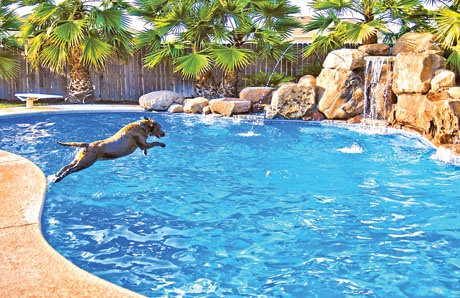Pool Pet Health: Minimize your pet’s exposure to swimming pool chemicals
—Updated July 2, 2025
Does your dog or kitty drink from your swimming pool?
When kids are splashing in the pool, does Fido jump in to join the fun?
Or maybe he dives in to fetch a ball that you toss in the water?Answering "yes" to any of the above means your pet is consuming chemically treated water—or swimming in it.
Now, if pool water is properly maintained, the levels of chlorine and other chemicals should be minimal. Therefore, an occasional sip or quick dip should be okay and won't affect your pet's health.
However, since well-balanced pool water isn’t always what your pet is drinking or swimming in, it’s a good idea to limit exposure when possible.
Let’s look at three ways to lower your pet’s contact with pool chemicals.

Cutting amounts of chemically treated water that pets consume
Animals see pools like giant, convenient drinking bowls. However, you don’t want Fido or Fluffy relying on the pool as a primary water source.
Before letting pets outside near the pool, encourage them to drink water from a regular bowl. Then, make sure to always have plenty of fresh drinking water on hand from an additional bowl that is kept outside.
To reduce the overall amount of water your pets may be tempted to lap up from the pool, take steps to help them from getting hot and thirsty in the first place.
Provide shaded areas close to the pool so that your animals have some shelter from the sun, while being close to the pool and the rest of the family.
Saltwater pools help—but have potential drawbacks for pets
Because they do not use traditional chlorine tablets or liquid and avoid some of their nasty side effects, saltwater pools have become increasingly popular.
To create a saltwater pool, special equipment uses electrolysis to convert ordinary salt into a type of chlorine. While it's a kinder, gentler form of chlorine (hypochlorous acid), it's still a chemical.
For animals, there is also the issue of the salt itself; although the salt content in these pools is only about one-tenth the level in the ocean.
However, if your pet needs to limit sodium in their diet for a health condition (e.g., heart disease, kidney disease), you should recognize that even occasional drinks could impact the pet’s overall level of salt consumption.
Alternatives to saltwater chlorination and traditional chlorine
Another strategy to help reduce your pet’s contact with chemicals: Keep fewer of them around in the first place.
Whether you are building a new pool or already have one, there are much better options to chlorine and salt systems: ozone generators and advanced oxidation process (aop).
—Ozone
Tens of thousands of pools nationwide and in Europe rely on ozonation and a tiny amount of chlorine to ensure a sparkling-clear swimming environment.
A naturally occurring molecule, ozone is comprised of three atoms of an element we breathe every day: oxygen.
Ozone is one of the strongest oxidizers on earth, instantly killing disease-causing pathogens like mold, fungus and bacteria.
However, it’s so safe and effective that it’s used to help purify drinking water in major cities and by bottled water companies.
A quality ozone system that provides virtually chlorine-free pool water is your best bet for pets.
It spares them from inhaling harsh chemical odors, and Fido’s fur won’t be sopping up any chemically treated water that can dull a shiny coat or dry out his skin.
Along with your pets, the entire family will enjoy the healthy, silky soft pool water as well!
—Advanced Oxidation Process (AOP)
Like ozone, AOP provides virtually chlorine-free purification for swimming pools.
This technology is the most advanced form of alternative pool water treatment.
It is even more powerful than ozone—achieving a 99.9% kill rate of harmful pathogens.
AOP even wins some battles that chlorine can't: It destroys E. coli, Giardia, Listeria, Salmonella, and Cryptosporidium (aka "Crypto").
In addition, it inhibits the growth of biofilm, a slimy bacteria that can coat pool surfaces that is also resistant to chlorine.
Despite this treatment packing a potent disinfection punch, it is safe for humans. In fact, it is so safe that it's used to help sanitize drinking water.
AOP achieves its disinfection power by combining ozone with UV germicidal light.
The marriage produces elements called hydroxyl radicals.
These scary-sounding compounds are lethal for unwanted organic contaminants, including mold, fungus, bacteria, algae, viruses, sweat, urine, and body oils. But they're 100-percent safe for swimmers.
You can learn more about AOP here: http://articles.bluehaven.com/what-is-advanced-oxidation-process-aop-for-swimming-pool-sanitization




.jpg?width=1490&name=rock-waterfall-slide-pool%20(1).jpg)